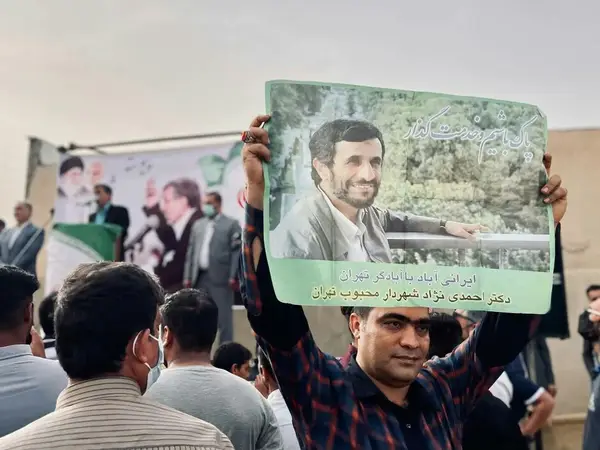Iran's former President Mahmoud Ahmadinejad is conspicuously nowhere to be seen these days as Iran experiences its biggest uprising in more than four decades.
Typically, the camera-loving populist politician would have seized the opportunity to ride the waves of nationwide protests, but he seems to be neither repeating his criticism of the system and its leader Ali Khamenei like an opposition figure, nor supporting the government to benefit from the advantages of being a loyal servant to Khamenei.
The latter, he has never been though, even during his presidency (2005-2013). He fell out with Khamenei in May 2011 over firing the leader's favorite intelligence Minister Heidar Moslehi, aka Heidar 007, and even refused to go to work for a couple of weeks.
Ahmadinejad has even cancelled his usual weekly meetings with his supporters in his modest neighborhood in Narmak in eastern Tehran or his office at Velenjak in the affluent northern Tehran, reported pro-reform news website Fararu. "Where is Ahmadinejad?" asked the website in an October 11 report. The economic daily Donya-ye Eqtesad wrote that this is in fact the continuation of his silence since ultraconservative Ebrahim Raisi took office as Iran's president in 2011.
Last time the former president was firing shots across the bow was in May-June 2021, before the presidential vote.
Ahmadinejad's former adviser, controversial politician Abdolreza Davari has opined that being in the spotlight while the unrest is continuing is not in the former President's interest.
It is vital for Ahmadinejad to safeguard his position at the Expediency Council although his relations with other council members are extremely limited as they do not like to approach the odd man.
It is important for Ahmadinejad to benefit from the protection his membership in the Council provides, particularly now that he has seen former presidents Mohammad Khatami and Hassan Rouhani not reinstated by Khamenei as members. Without this membership, he has no official position in Iran whatsoever, Davari told Fararu.
Ali Ghaffarian, the editor of conservative Sarat News told Donya-ye Eqtesad that either Ahmadinejad has decided to be silent or he has been silenced by the government. However, as he is not likely to submit to anything imposed on him, most probably, it is his own decision to remain on the side-lines amid the uprising.
According to Rouydad24, a moderate news website, the regime also benefits from Ahmadinejad's membership in the Expediency Council, because that puts him on a short leash.
Rouydad24 wrote that Ahmadinejad has lost many levers and even many of his close allies in recent years. This has prompted him to present a different picture of his presidency after a decade, hoping that the people have forgotten what they saw particularly after the disputed 2009 election in which the IRGC assisted him to keep the presidency for a second term.
The website wrote that some of Ahmadinejad's comments portray him as more reformist than famous reform front politicians. But he is neither a conservative, nor a reformist. He is a third kind of politician. "One that looks you in the eye and lies," as presidential contestant Mir Hossein Mousavi said in 2009.
His criticism of the latest round of presidential elections in Iran can well apply to his own election particularly in 2009: "You have limited the cyberspace, ban people from assembly. The people do not have a media outlet of their own and you do not listen to them even when they do not take part in elections or cast blank ballots."
Meanwhile, he interprets popular slogans against the two leading political factions as sign of support for himself. But the people have not said a word in his support neither during the past weeks nor at any other time in previous protests since 2017.
During the past decade, Ahmadinejad constantly spoke about change and now that the opportunity has arrived, he has chosen not to talk about it. He has separated himself from the government as much as he possibly could, but lack of visible grassroot support has left him isolated. And with his background it is unlikely that the youngsters who have taken to the streets like an unstoppable flood would see him or his vaguely defined populist plans anywhere in the bigger picture they have in mind for Iran's future. This also applies to the other two former presidents who have even less public support than Ahmadinejad and remain silent about the biggest shock to the Islamic Republic.
